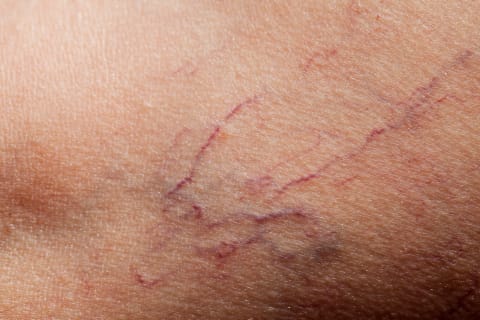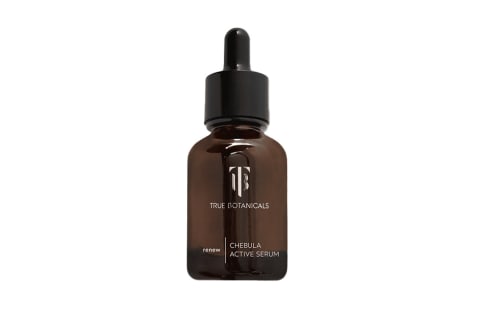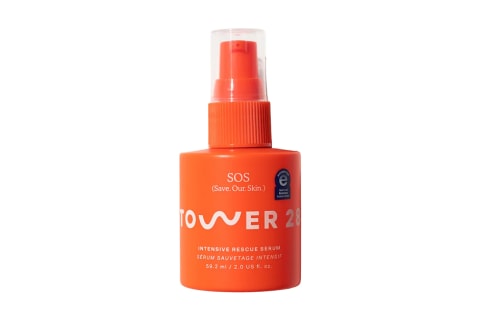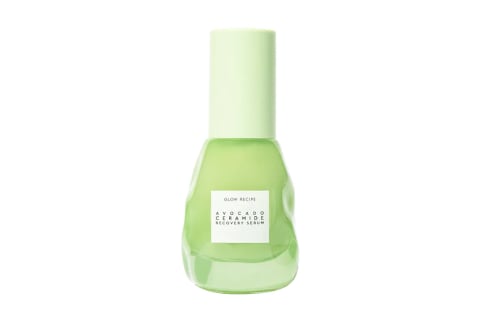Advertisement
Why Do I Get Broken Capillaries On The Face? We Explain + Tips


Everyone's skin is unique, and that's the beauty of it. Even if Photoshop has you convinced that there's someone out there with "perfect" skin, there's no such thing. If you've noticed breakouts, fine lines, texture, or tiny red veins on your skin, you're not alone.
If the latter of the list sounds familiar, you might be dealing with what's known as broken capillaries. These can show up for a variety of reasons (some you may not even be aware of!).
Luckily, there are a few ways to help minimize their appearance should you want to cover them up. Consider the following your full guide to broken capillaries, with all of your questions answered. Let's dive in.
What are broken capillaries?

If you've noticed tiny red lines on your skin that resemble mini veins, you might actually be looking at dilated capillaries, not necessarily broken ones. "Actual broken capillaries result in bruising as blood is allowed to leak out into surrounding tissue," board-certified dermatologist Rebecca Marcus, M.D., FAAD, tells mbg.
"Dilated capillaries, on the other hand, result in tiny red blood vessels that are visible at the skin's surface," she says. These fine branchlike vessels are always underneath the surface but may appear more pronounced in certain areas—oftentimes around the nose and on the cheeks.
There's a long list of potential causes for dilated and broken capillaries, some common and others not so much. Those with rosacea frequently have these tiny red vessels on display, but more on that in a bit.
Summary
Where on the face do you get them?
While these are most common on the cheeks, nose, and the chin, you can get broken blood vessels anywhere on the face. What's more, they show up on the body too.
You may have heard the term "spider veins1" to describe broken capillaries spotted on the legs or upper arms—these are extremely common and often appear due to similar causes. These visible vessels may also be referred to as telangiectasia in medical terminology.
Causes of broken capillaries on the face
To get a better understanding of why this happens, here's a quick overview of the most common causes.
Rosacea
As mentioned above, those with rosacea may see dilated or broken capillaries more often. "Rosacea-induced inflammation and repeated episodes of flushing lead to dilated capillaries that can become permanent," Marcus explains.
"These broken blood vessels at the surface are often a hallmark of this skin condition," board-certified plastic surgeon Jaimie DeRosa tells mbg. So if you're seeing these tiny vessels on a regular basis, you may want to consider visiting a dermatologist to rule out rosacea before attempting to reduce them via at-home treatment.
In order to minimize the occurrence and appearance of broken capillaries, those with rosacea should focus on limiting triggers that lead to inflammation—more on that to follow.
Harsh treatments
"Harsh topicals and exfoliants such as strong percentage acids like AHAs and BHAs as well as gritty scrubs can lead to broken capillaries," celebrity aesthetician Joshua Ross tells mbg. So if you're noticing these tiny vessels after starting a new exfoliant, you may want to consider opting for a more gentle formula.
Picking at pimples
Just as harsh scrubs can damage the skin and lead to broken capillaries, so can other forms of physical damage, such as picking at or popping pimples. Plus, there are even more problematic side effects including scarring, dark spots, infection, and so on.
Squeezing the skin too hard is considered an "external trauma," DeRosa says, even if you're just trying to manually clear out minor blackheads.
In short, don't pop your pimples—even if they seem "ready."
Heat
"Extreme heat causes blood vessels near the skin to dilate as a way of trying to help maintain cooler temperatures at the body's core by releasing heat through the skin," Marcus notes.
This can be both internal and external heat. If you're noticing these capillaries show up mostly after a hard workout, being outside on a hot summer day, or after you wash your face with warm water, heat may be the trigger.
Sun exposure
"UV radiation can damage blood vessels close to the surface of the skin, causing their walls to thin and making capillaries more likely to break," Marcus explains.
She adds that this kind of damage to the skin may lead to bruising, "Causing persistent redness and visible capillaries on the surface of the skin."
In addition to broken capillaries, "UV radiation causes DNA damage that results in loss of collagen, loss of elasticity, and discoloration," Marcus notes. So if you're noticing hyperpigmentation or "sun spots in addition to broken capillaries, you'll want to practice safe sun from here on out."'
Diet
Just as skin conditions like rosacea can be triggered by certain foods, so can broken capillaries. "Alcohol can cause capillaries to dilate, making them more fragile and also more visible at the surface of the skin," Marcus notes.
Things like spicy foods and caffeine can also contribute to facial redness, Ross explains, because they can increase inflammation in the body, which then leads to, "Skin stress," he says.
Yes, you can have them naturally
If you've noticed these tiny vessels regardless of any of the causes above, you may be particularly prone to broken capillaries. "There can be a genetic component to the development of dilated or broken capillaries, so some people are more prone than others to this condition," Marcus says.
"In addition, there are certain genetic disorders whose symptoms include fragile blood vessels," she adds.
So while you may not be able to control the formation of these broken capillaries, you can reduce their appearance—more to come next.
Treatments for broken capillaries on the face
If you already have these tiny vessels showing, gently tending to the skin is essential, as persistent dilation on capillaries can cause capillaries to become permanently dilated, Marcus says. Here's the 101:
Switch to a soothing, anti-inflammatory skin care routine
If you're not already doing so, switch to gentle, soothing, and anti-inflammatory skin care products. "I suggest using a gentle exfoliation such as a low percentage lactic acid or a gentle manual exfoliation such as washcloth with a cream cleanser," Ross notes.
Look for serums and moisturizers with colloidal oat, calendula, and peptides, Ross suggests. Picking up a vitamin C serum may also help, "One of the benefits of vitamin C is that it is an anti-inflammatory bioflavonoid, which helps to stabilize and repair weakened blood vessels," DeRosa explains.
To sum up, try your best to include a few of these ingredients in your topical care:
- Peptides
- Oat oilc
- Niacinamide (it is important to make sure your product contains niacinamide or nicotinamide, not niacin or nicotinic acid. The latter two can actually increase flushing!)
- Calendula
- Vitamin C
- Lactic acid (rather than stronger exfoliants)
If you're unsure which steps in your skin care routine could be triggering broken capillaries, visit your dermatologist or a licensed esthetician to talk about the best possible swaps.
You can also check out this guide to reducing redness on the face.
Avoid heat when possible
Even if you don't splash steaming hot water on your face, you may still be subject to heat-induced inflammation. Try to avoid taking hot showers that produce excessive steam, and consider opting out of saunas for the time being. If you really must hit the heat, you may want to have a cool washcloth on hand to keep your facial temperature down.
Instead, focus on cooling the skin. Marcus recommends using an ice roller for a gentle and soothing dose of chill—here's a list of the 9 best options on the market if you're ready to adopt this step.
Wear sunscreen daily
Wearing sunscreen daily and avoiding excessive sun exposure when you can may help reduce broken capillaries and can help maintain collagen and elastin which helps to protect those tiny blood vessels. Look for a formula that is mineral based and contains additional soothing ingredients like oat, squalene, or vitamin E to really get a bang for your buck.
Mind what you eat and drink
While everyone has different triggers for skin inflammation, reducing alcohol, caffeine, and spicy food is a good place to start. If you want to know exactly which categories of inflammatory foods are causing your broken capillaries, try to pay close attention to which foods or beverages make your skin flush, DeRosa says.
Consider LED light therapy
"Red-light LED devices can be helpful to promote healing of the broken vessels," DeRosa notes. You can opt for an at-home device or visit a dermatologist to get an in-office treatment.
Visit a derm for professional treatment
"Intense pulsed light, pulse dye laser, and several other types of laser can be used to target dilated blood vessels," Marcus says. These treatments won't be the best for everyone, so it's important to listen to your dermatologist's recommended method of action.
Try a topical medication
If none of the above help to reduce the appearance of broken capillaries on your skin, your dermatologist may prescribe you a topical medication. One of them is Rhofade, as it temporarily constricts small blood vessels near the surface of the skin, Marcus explains.
3 Products Safe For Broken Capillaries
DIY remedies for broken capillaries
If you want to give a DIY remedy a shot before investing in topical products or a medical visit, you'll want to focus on soothing ingredients. There are plenty of easy and affordable ways to do just this—here are our top three.
A yogurt face mask
Remember when we mentioned lactic acid as an A+ ingredient? Well, yogurt is packed with this gentle exfoliant, making it a perfect base for a natural mask.
While Greek yogurt tends to have the best consistency for face masks, you can also choose coconut or soy yogurt for a vegan option—just try to find one that includes added probiotics so your skin microbiome can still reap the benefits.
Once you have your yogurt base, you can add in honey, oatmeal, avocado, or even certain herbs—here's a breakdown with a few different mask recipes and their benefits if you're ready to whip something up.
Aloe vera ice pops
Let's be real—nobody can avoid heat at all times. So if your skin feels inflamed post-workout or after being in the sun, opt for an aloe vera ice pop to cool it down. Think of it like a refreshing ice pop for your skin.
You can either blend fresh aloe vera or use a premade product—here's the exact recipe and a bit more about the benefits if you're curious.
A cold compress
If you want something low-lift, this one is for you. DeRosa recommends a cold compress whenever your skin feels inflamed. You can either soak a clean wash rag in a bowl of cold water or even pop it in the freezer for a few minutes.
Place the rag over your face and leave it there for a few minutes, or until your skin feels soothed. Avoid rubbing the cloth on your face as the physical abrasion may cause a rash or further irritation.
FAQ
Do broken capillaries go away?
Some broken capillaries will go away, while others may be permanent. It's important to note that, "Persistent dilation on capillaries can cause capillaries to become permanently dilated," Marcus says. This is why prevention and treatment should be used in conjunction to manage broken capillaries.
Does alcohol make broken capillaries worse?
Diet triggers will differ from person to person, but alcohol is a common culprit for broken capillaries. "Alcohol can cause capillaries to dilate, making them more fragile and also more visible at the surface of the skin," Marcus notes.
How much do treatments for broken capillaries cost?
Intense pulsed light (IPL) treatment is often used to minimize the appearance of broken capillaries. Depending on who you visit and the condition of your skin, IPL can cost anywhere from $700 to $1,000. Because this is often used as a cosmetic treatment, most insurance will not cover the cost, though on occasion partial coverage may be an option.
The takeaway
Red spider veins on the face and the body have a list of causes, from rosacea to UV induced damage to general inflammation. The best way to ease the appearance of these tiny vessels is to prioritize gentle skin care products, avoid heat when possible, practice good UV protection, and consult a dermatologist for more information and perhaps topical prescriptions.
But remember: These tiny lines are just that: tiny. There's a good chance you're noticing them more than other folks, so try not to let them bother you too much in the meantime.
As a bonus, if you're looking for more ways to soothe the skin, here are 10 all-natural tips to get you started.


